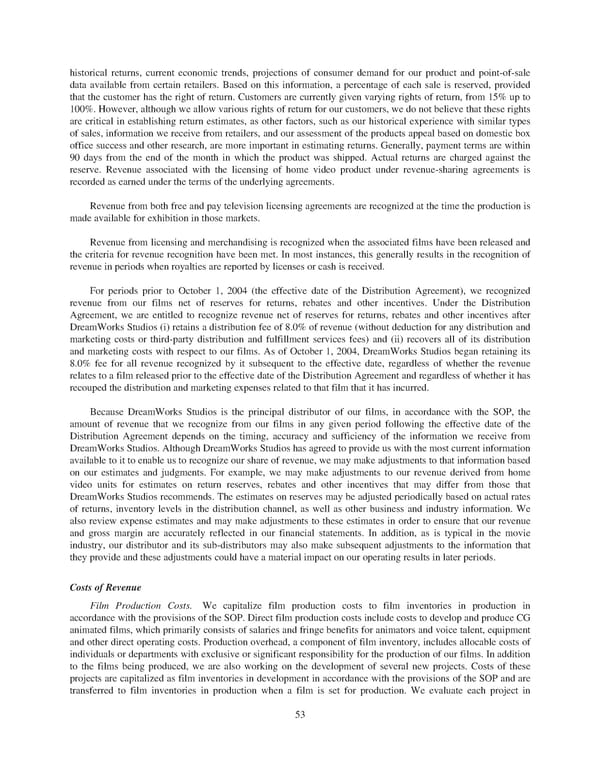historical returns, current economic trends, projections of consumer demand for our product and point-of-sale data available from certain retailers. Based on this information, a percentage of each sale is reserved, provided that the customer has the right of return. Customers are currently given varying rights of return, from 15% up to 100%. However, although we allow various rights of return for our customers, we do not believe that these rights are critical in establishing return estimates, as other factors, such as our historical experience with similar types of sales, information we receive from retailers, and our assessment of the products appeal based on domestic box office success and other research, are more important in estimating returns. Generally, payment terms are within 90 days from the end of the month in which the product was shipped. Actual returns are charged against the reserve. Revenue associated with the licensing of home video product under revenue-sharing agreements is recorded as earned under the terms of the underlying agreements. Revenue from both free and pay television licensing agreements are recognized at the time the production is madeavailable for exhibition in those markets. Revenue from licensing and merchandising is recognized when the associated films have been released and the criteria for revenue recognition have been met. In most instances, this generally results in the recognition of revenue in periods when royalties are reported by licenses or cash is received. For periods prior to October 1, 2004 (the effective date of the Distribution Agreement), we recognized revenue from our films net of reserves for returns, rebates and other incentives. Under the Distribution Agreement, we are entitled to recognize revenue net of reserves for returns, rebates and other incentives after DreamWorks Studios (i) retains a distribution fee of 8.0% of revenue (without deduction for any distribution and marketing costs or third-party distribution and fulfillment services fees) and (ii) recovers all of its distribution and marketing costs with respect to our films. As of October 1, 2004, DreamWorks Studios began retaining its 8.0% fee for all revenue recognized by it subsequent to the effective date, regardless of whether the revenue relates to a film released prior to the effective date of the Distribution Agreement and regardless of whether it has recouped the distribution and marketing expenses related to that film that it has incurred. Because DreamWorks Studios is the principal distributor of our films, in accordance with the SOP, the amount of revenue that we recognize from our films in any given period following the effective date of the Distribution Agreement depends on the timing, accuracy and sufficiency of the information we receive from DreamWorksStudios. Although DreamWorks Studios has agreed to provide us with the most current information available to it to enable us to recognize our share of revenue, we may make adjustments to that information based on our estimates and judgments. For example, we may make adjustments to our revenue derived from home video units for estimates on return reserves, rebates and other incentives that may differ from those that DreamWorks Studios recommends. The estimates on reserves may be adjusted periodically based on actual rates of returns, inventory levels in the distribution channel, as well as other business and industry information. We also review expense estimates and may make adjustments to these estimates in order to ensure that our revenue and gross margin are accurately reflected in our financial statements. In addition, as is typical in the movie industry, our distributor and its sub-distributors may also make subsequent adjustments to the information that they provide and these adjustments could have a material impact on our operating results in later periods. Costs of Revenue Film Production Costs. We capitalize film production costs to film inventories in production in accordance with the provisions of the SOP. Direct film production costs include costs to develop and produce CG animated films, which primarily consists of salaries and fringe benefits for animators and voice talent, equipment and other direct operating costs. Production overhead, a component of film inventory, includes allocable costs of individuals or departments with exclusive or significant responsibility for the production of our films. In addition to the films being produced, we are also working on the development of several new projects. Costs of these projects are capitalized as film inventories in development in accordance with the provisions of the SOP and are transferred to film inventories in production when a film is set for production. We evaluate each project in 53
 DreamWorks Annual Report Page 58 Page 60
DreamWorks Annual Report Page 58 Page 60